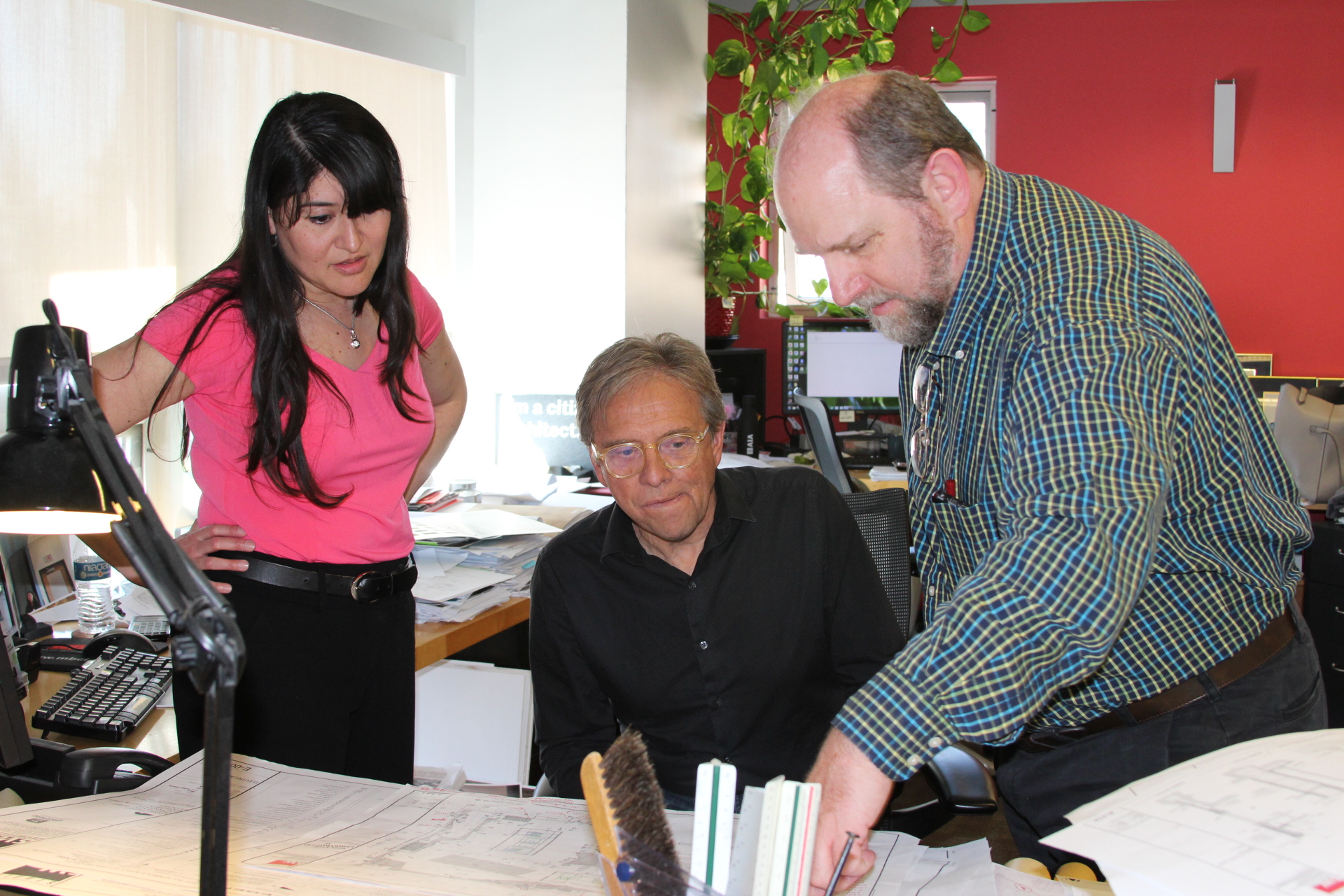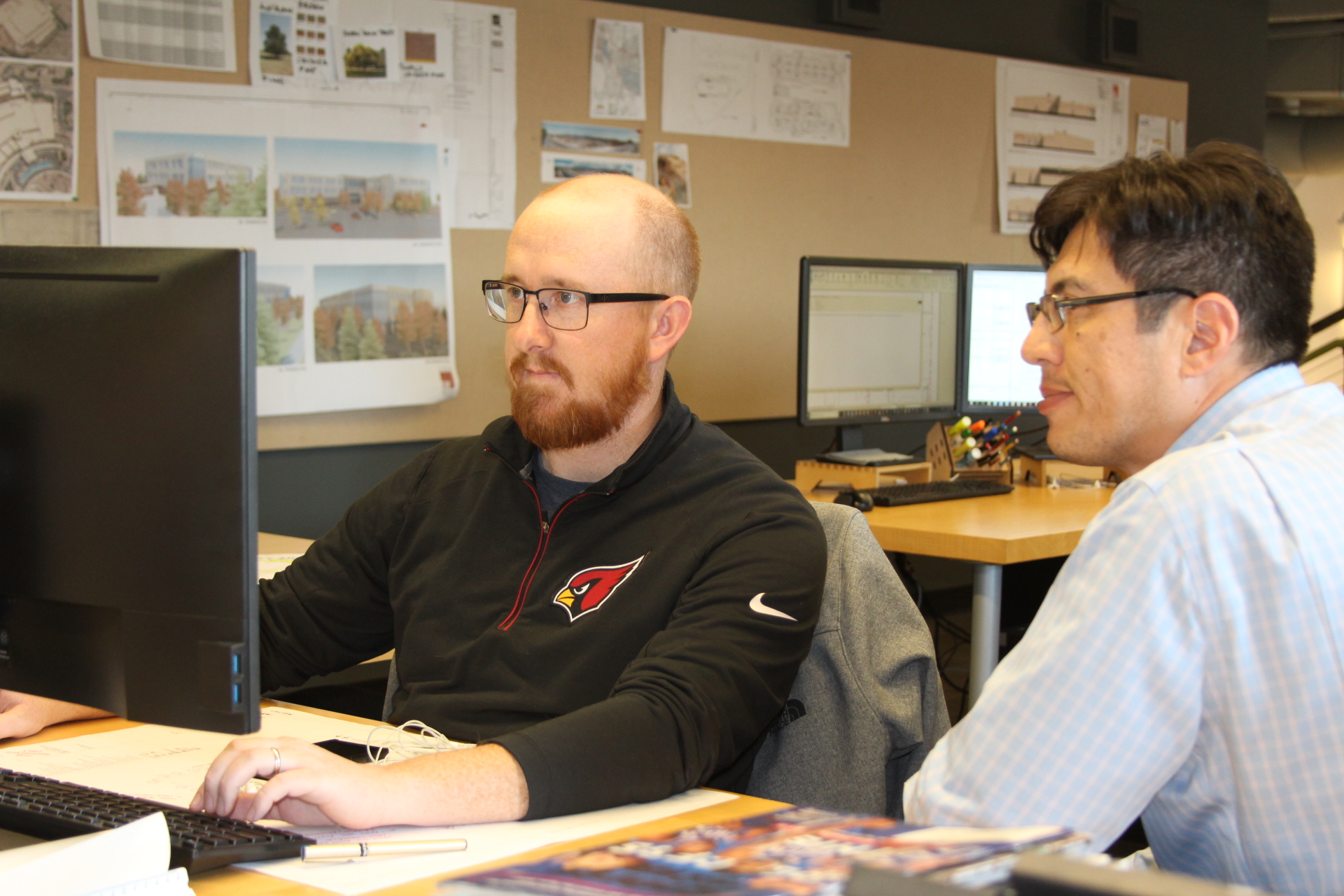By: Donna Marion, AIA, LEED AP BD+C
“We as people, as learners, as growers, have to begin to think about the world beyond ourselves. There’s so much knowledge out there for us to soak in, and there’s so much for us to give.”
Kam Phillips, TEDx Talk, Mentorship Will Change the World
Mentorship is integral to our lives as architects. As much as we learn in school, architecture is structured more like an apprenticeship – we are expected to learn a great deal through on-the-job experience.
Just as we learn from others, it is our responsibility and obligation to pay it forward, teaching what we know, and better learning what we teach.
Why Mentorship is So Important
For Mentees
On the surface, the benefits for the mentee are the most obvious. Mentees get the chance to receive honest feedback and guidance from someone more experienced in their field. It’s even better if the mentor does not work directly with the mentee, and can give candid, unbiased commentary – and the mentee can speak openly without fear of conflict.
For architects, mentorship is particularly important, as on-the-job training is a critical part of our learning process. It’s so ingrained into our development that in order to become a registered professional, we need to log three years worth of intern hours in particular categories under the supervision of a registered architect. This architect is, effectively, a type of mentor, with the responsibility of overseeing our work as a developing intern.
Mentors can also act as champions for their mentees, opening opportunities for them and speaking their concerns from a place of higher authority.
Mentorship doesn’t have to be formal, and can be as simple as taking a sincere interest in someone’s development and giving them a gentle nudge in the right direction. I experienced this one afternoon when I remarked to one of my senior supervisors that I was making great efforts, and struggling, trying to catch up with the office’s ‘rendering guru.’ Without skipping a beat, my supervisor responded, “Don’t become good at something unless that’s what you really want to be doing.”
My whole career I had jumped at all these opportunities, tried to become good at everything, almost aimlessly – not realizing that this could actually lessen my agency in determining what direction I wanted my career to go. It was an important lesson: understanding that we have finite time, and prioritizing our efforts is a requirement, not an option, if we want any say in our future. Thanks to my supervisor caring about my professional development, and sharing this lesson, I didn’t have to learn this the hard way.
For Mentors
Mentors also benefit from this relationship. Teaching concepts forces us to articulate them, which is a great exercise in understanding in and of itself. When making decisions day to day, we don’t necessarily go through the exercise of articulating why and reflecting on whether or not these were the right choices, but when explaining them to a mentee, we must.
There’s also the opportunity for self-reflection. We can become better managers by diagnosing issues brought up by our mentees and thinking about how these apply to our own project teams.
Mentees also act as an “ear to the ground” for the mentor, a way to gauge how teams are performing internally, and an honest portrayal – easier to achieve through a mentorship relationship rather than through a supervisor/working with someone directly.
“Mentorship is often a more reciprocal relationship than it may appear, especially in situations where people are already working at the same company. The mentee may receive more direct assistance, but the mentor receives benefits too, including useful information, greater commitment from colleagues, and a sense of fulfillment and pride… When done right, everybody flourishes.”
Lean In, Sheryl Sandberg
These aren’t mutually exclusive identities either. We are often a mentee and a mentor, as we can always aspire to our role models, and pay it forward to those less experienced than us. Our relationship with a mentee can help us think about bettering our relationship with our mentors.
For Organizations
Individuals aren’t the only ones who benefit for mentorship. Entire organizations do. The benefit is more than the sum of its parts; the office is more than just the sum of its people.
If you can create a culture that supports candid, thoughtful feedback – which we’ll explore more later on – it will continue reaping benefits over time. Employees will develop greater skills and be more invested in each others’ success. Through their growth, individuals will make greater contributions and produce higher quality work.
There’s also employee retention and job satisfaction, which is highly correlated to having meaningful relationships with coworkers.
“According to research statistics, employee satisfaction skyrockets nearly 50% when a worker develops a close relationship on the job.”
The Truth About Job Satisfaction and Friendships at Work, National Business Research Institute
Humans are social creatures. When people flourish, organizations flourish.

What Makes for Good Mentorship
Effective mentorship has specific defining characteristics: candid exchange of opinions; both parties are invested in the relationship, so it is mutually beneficial; and go deep, not wide.
It’s hard to give and receive feedback to someone you work with directly. A mentor can offer this valuable insight in a low-pressure setting. Keeping the exchange honest is makes the relationship valuable to everyone involved.
Both parties being invested in the relationship is crucial;. This means actually getting to know each other as individuals, as people, with unique personalities and individual aspirations and concerns.
“If a mentee is struggling with relationships with executives, hiring decisions, gaps in their skill set, motivating their team – having a more developed sense of who they are as a person will help elicit the best advice for handling it. Personality, introversion, extroversion, how they manage time, and what they enjoy doing will all make a difference.”
First Round Mentorship Program
“Go deep, not wide” means providing in-depth guidance to a few mentees is more valuable than shallow guidance to many. If you as a mentor can’t remember details about your mentee such as their interests, how far along they are in the registration process, then you are not close enough to be meaningfully helpful to them.
Mentorship doesn’t have to be structured for it to be impactful, and it is not a series of question-and-answer sessions. The heart of the matter is: taking an interest in someone’s development, and providing sincere feedback, sharing relevant experiences, and encouraging the development of their own insights and problem solving skills.

Wrestling, Drawing, and Muscle Memory
My final year in the Masters program, I had the privilege of teaching an architectural hand drawing course under a professor I greatly admired. The first exercises focused on physical technique and consisted of drawing straight, parallel lines, over and over. It’s boring, but an incredibly useful starting point, because by observing the students in the simple act of drawing a straight line, we can provide feedback early on and help form their technique.
Most students (begrudgingly) made their way through the task, but one student seemed to consistently rush, as if careless and uninterested. On the other hand, he participated in class, asked questions, paid attention when we spoke. So why wasn’t he taking our feedback?
During a deskcrit one day, I noticed he had cauliflower ear – a telltale sign of a wrestling background. Then it hit me.
Most students – myself included – draw our lines across the page slowly, adjusting our posture and pressure as we watch the behavior of the line. Too dark, lighten the pressure; curving down, adjust the rotation of the wrist; we make slight adjustments to our technique as we notice deviations in our attempt at a “perfect” line. This student, however, was relying entirely on muscle memory. He attempted to replicate the quality of the line by, each time, using the same speed and posture as the line before.
I asked him, “Are you a grappler?” He seemed surprised at the question but said yes.
“Okay,” I said, “I know you think it’s strange for me to ask you that – but I think it’s affecting the way you draw. Let’s work with that.” I explained the conclusion I’d drawn, and the difference between drawing via muscle memory, and drawing by visual referencing.
His response was astounding. Immediately there was a change. His efforts were clumsy at first, adjusting to slow, precisely controlled movements, but his improvements were visible even over the course of that one class hour. At day’s end I suggested he practice different lineweights in his notebook, focusing on how each weight felt; if he could work that into his muscle memory, he could incorporate the way his body naturally wanted to work with the techniques that were expected of him.
He may never have become an A+ student, but he grew substantially over the course of the semester, and I’m confident he tapped deep into the wells of his potential. Meanwhile, I’m thankful that instead of writing off his actions as disinterested, that instead I took a moment to first examine and understand.

How to Implement Mentorship in the Office
There are many ways to foster mentorship in the office, but here I’ll focus on two basic categories: formally, and informally.
Formally
Setting up a formal program creates a structured mentorship environment with at least a few basic rules.
Ideally, mentees and mentors are paired based on shared interests, with a reasonable but not enormous experience gap, and are not people who tend to work together directly on a day-to-day basis. This will allow for greater honesty when talking about challenging work situations.
The ideal experience gap is 5-10 years. That far out, the mentor is experienced but can still remember what it felt like to be in their mentee’s shoes.” FirstRound.com / First Round Mentorship Program
Encourage mentee-led agendas, which ensure the mentee is prepared, and that the intentions of each meeting are clear. This makes sure the content is relevant to the mentee at their point of development and highlights their priorities to their mentor. It is also respectful of the mentor’s time; time spent thinking “what should we be talking about?” is unnecessarily wasted time.
Set a loose schedule – such as meeting once a month – with an optional end date. The mentorship can continue beyond then if desired, but this also sets a convenient exit date or opportunity for a better matchup if the original isn’t quite the right fit.
Informally
To foster mentorship informally, create a culture that rewards frequent candid feedback.
“Simultaneously care personally, and challenge directly.”
Kim Scott and Russ Laraway, Radical Candor
When feedback and advice are shared freely and tactfully (both are important!) mentorships will emerge organically. Kim Scott and Russ Laraway call this “a culture of radical candor” and discuss how to achieve this in their podcast episode:
As with many things, change comes from within, so a top-down approach isn’t going to be the most effective. Instead, consider leading by example, regardless of your position within the office. When you request feedback regularly, and show that you receive criticism well, others will be more inclined to offer the feedback unsolicited. Likewise, your eagerness to share your skills and enthusiasm in others’s success will be contagious.
“If you want your team or your company or even just your peers around you to start being more open to feedback, the best thing that you can do is to show them how open you are – not just open, but eager for it, and to show them how much it helps you. When people see you making changes based on their feedback, they’re going to be encouraged to make some changes too.”
Kim Scott, Radical Candor
If you see a change to be made, don’t wait or wonder why someone else isn’t taking care of it. Do it yourself. Be the change. Plant the seed, tend the garden, and with time the change will grow.
“We don’t all start out on a level playing field. Sometimes it does take someone else to come along and plant the seed that we need to grow to become the greatest version of ourselves.”
Brit Fitzpatrick, TEDx Talk, How Mentoring Can Reshape Our Communities

Donna Marion, AIA, LEED AP BD+C
Donna is a Project Manager at Studio SW. She has a background in Architecture and Physics, giving her a unique perspective on design and leadership. Donna sees the benefit of positive mentorship and strives to provide quality feedback to every project team.




